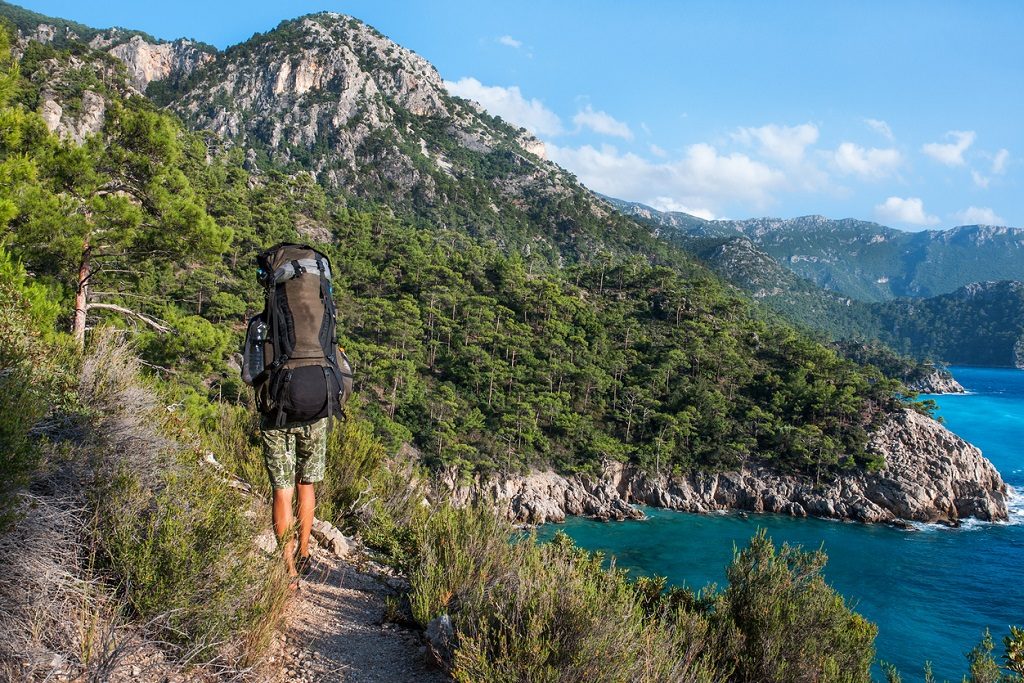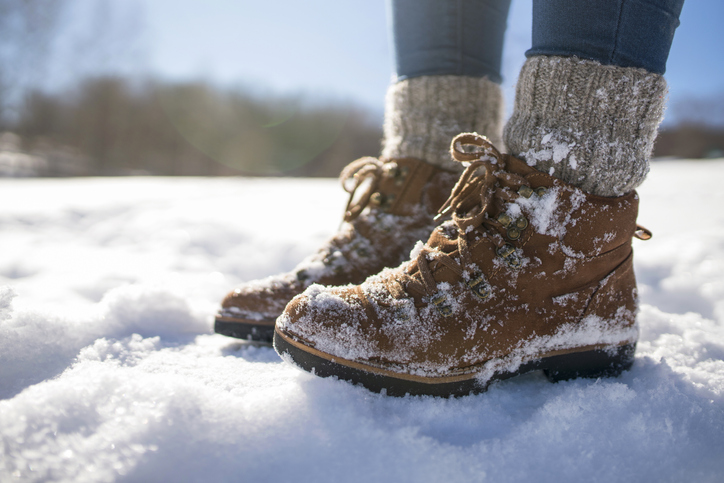Choosing the right pair of hiking shoes is like a matchmaking process. Really tough to find the right one but when you finally do, it’s a dream. These ‘dream’ hiking shoes are in perfect sync with how and where you hike. No doubt, hiking shoes are the most critical gear, as the right pair will help you glide down the trail with a smile on your face, while poor-quality shoes will have you gritting your teeth with every footfall.
So, we have to forget about the looks, flashy features or even friend’s recommendations (unless their feet are identical to yours) while picking the right kind of hiking shoes for you. With so many styles to choose from, and what feels good in the store, we need to remember the following things when it comes to selecting the right pair of hiking shoes for you:
What kind of hike are you planning?

Different kinds of shoes are suitable for different kinds of treks, depending on the weather, trail condition (the kind of terrain you’ll encounter), and your mobility. Therefore, it is integral to determine what kind of hiking are you planning for and which hiking shoes will best suit your needs. Also factor in the duration of the trail with conditions of the trail (well-defined trail, rugged trail, rain, snow, glacial-pass traverse, etc.) as you’ll need to select your shoes based on the terrain you will hike on.
Shoes or Boots
One of the commonly asked questions by beginner hikers is: Should I pick a low-cut shoe or mid-height boot? If you have the same doubt, don’t worry! We can clear it for you: A pair of hiking boots often weigh several ounces to a pound more than shoes, but the weight is one of several concerns. The trail conditions, distances to cover and personal ankle and foot strength are all important factors that should be considered before choosing between a pair of hiking boots or hiking shoes. Also remember that hiking boots provide more protection from mud, snow, and water, and they are a necessity for rough terrain with heavy loads. They are also warmer than a low-cut shoe.
Also Read: 15 Brilliant Hiking Hacks Every Hiker Needs To Know
Weight of your backpack
 “Hiking” includes a whole range of fun-on-your-feet adventures, including day hikes requiring minimum essentials. These could either be strolls on maintained trails or they could be many miles covered at speed in rough terrain and everything in between. Hiking also encompasses short backpacking trips with light or medium loads or long fastpacking trips; here cutting down the weight becomes a priority. For example, while carrying heavier backpacks you’d require sturdiness and flexibility. You will need a full range of motion, but also the kind of protection that’ll stop our feet from bending too far backwards or forwards.
“Hiking” includes a whole range of fun-on-your-feet adventures, including day hikes requiring minimum essentials. These could either be strolls on maintained trails or they could be many miles covered at speed in rough terrain and everything in between. Hiking also encompasses short backpacking trips with light or medium loads or long fastpacking trips; here cutting down the weight becomes a priority. For example, while carrying heavier backpacks you’d require sturdiness and flexibility. You will need a full range of motion, but also the kind of protection that’ll stop our feet from bending too far backwards or forwards.
Your Experience
 Your hike trail will vary if you are a casual hiker or do you spend more time deep in the mountains than at home. Your skill, ability due to your previous experiences will determine what kind of hiking shoes would you be most comfortable with. For example – experienced hikers will have more resistance to rolled ankles and tweaked knees. Their leg muscles have been optimised from enough time on the trail.
Your hike trail will vary if you are a casual hiker or do you spend more time deep in the mountains than at home. Your skill, ability due to your previous experiences will determine what kind of hiking shoes would you be most comfortable with. For example – experienced hikers will have more resistance to rolled ankles and tweaked knees. Their leg muscles have been optimised from enough time on the trail.
Therefore, it is said that the more your “hiking muscles” strengthen the more support you can shed off your boot. As your feet get stronger you can move towards lighter hiking shoes.
The size and fit
 The most important thing about buying your hiking shoes is to get a good fit. Because if not, you might get blisters, blackened toenails, sprained arches, bone spurs, plantar fasciitis. The best size for you will be a snug fit at the heel and wiggling room for your toes in front. Get to know your size properly as your feet take on the bulk of the work on hiking excursions. So it’s important that they have the right padding and protection. Ignore the size numbers and choose a shoe/ boot that feels right for your foot size. This may mean you buy a pair one size larger than your normal size.
The most important thing about buying your hiking shoes is to get a good fit. Because if not, you might get blisters, blackened toenails, sprained arches, bone spurs, plantar fasciitis. The best size for you will be a snug fit at the heel and wiggling room for your toes in front. Get to know your size properly as your feet take on the bulk of the work on hiking excursions. So it’s important that they have the right padding and protection. Ignore the size numbers and choose a shoe/ boot that feels right for your foot size. This may mean you buy a pair one size larger than your normal size.
Always try them with your hiking socks to get an accurate feel for comfort and fit. Or if that isn’t possible, buy socks and boots at the same time because little details like toe seams and overall thickness can cause or relieve pressure problems.
Material
 As you have to wear the same shoes for the entire duration of your hike, its best to give an equal amount of importance to the kind of material they are made of. Is the fabric breathable? Comfortable enough? Waterproof? The water inside our shoes will not only lead to odour but can also cause blisters. So, the material should allow our feet to “breathe” and let perspiration escape.
As you have to wear the same shoes for the entire duration of your hike, its best to give an equal amount of importance to the kind of material they are made of. Is the fabric breathable? Comfortable enough? Waterproof? The water inside our shoes will not only lead to odour but can also cause blisters. So, the material should allow our feet to “breathe” and let perspiration escape.
Because, the wrong kind of fabric can make your feet feel hot, itchy and cramped. This, in turn, might lead to sore feet, inflamed tendons, blisters or worse! So, find the right material for ultimate trail comfort.
Cut
Hiking boots come in all different cuts, and this should especially be tailored to your type of trekking. Keep in mind that, the wrong cut could cause a rolled ankle or rocks in your shoes. There are three cuts to consider: Low cut (for lightweight, casual hiking), mid-cut (for more ankle support and balance) and high cut (for adventurous hikers and their habits of traversing potentially dangerous terrain).
Weight, Support & Traction
 Weight is a key factor while buying your hiking shoes as it is said: the heavier the boot, the more work for our legs. And with more weight, you also need to see if it’s supportive and gives the best traction for your chosen terrain. The amount of support you need depends on how many miles you have to hike, how smooth or rough the terrain is, and how much weight you are carrying. Stiffer, more supportive shoes also reduce foot fatigue when carrying a pack.
Weight is a key factor while buying your hiking shoes as it is said: the heavier the boot, the more work for our legs. And with more weight, you also need to see if it’s supportive and gives the best traction for your chosen terrain. The amount of support you need depends on how many miles you have to hike, how smooth or rough the terrain is, and how much weight you are carrying. Stiffer, more supportive shoes also reduce foot fatigue when carrying a pack.
Our advice is to choose the lightest footwear that meets your needs for support and expectations of durability.
Pro Tip: never take your shoes out of the box and head directly to the trail. Take time to break them in before your outing. Purchase your boots and wear them around your house or while running errands to break them in. You’ll know if they are the ‘RIGHT ONES’. While a good pair of shoes can feel like an extension of your feet, a bad pair can feel like thorns on your feet.
So, go ahead and pick the best hiking shoes for you! Do let us know about your experiences below!


